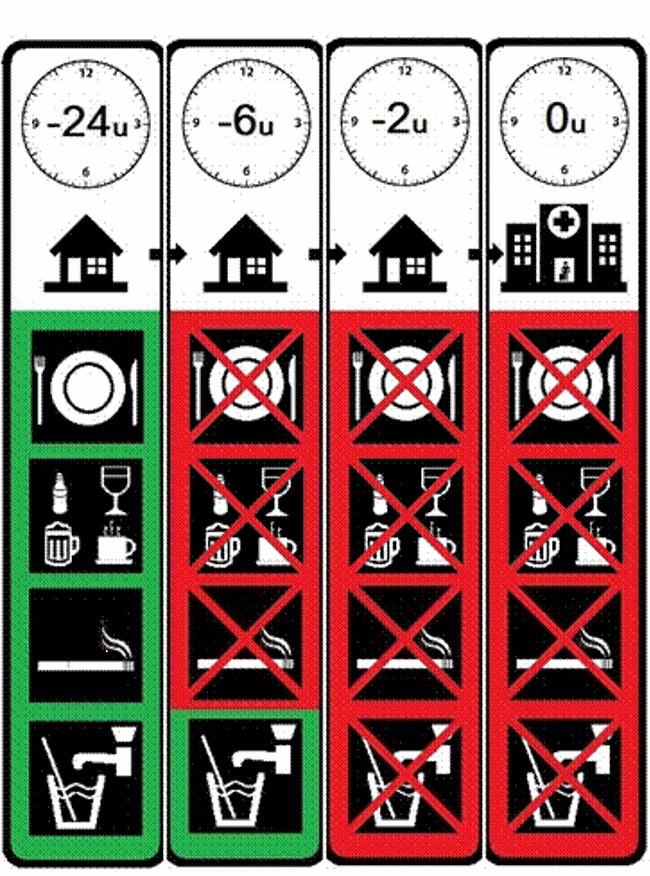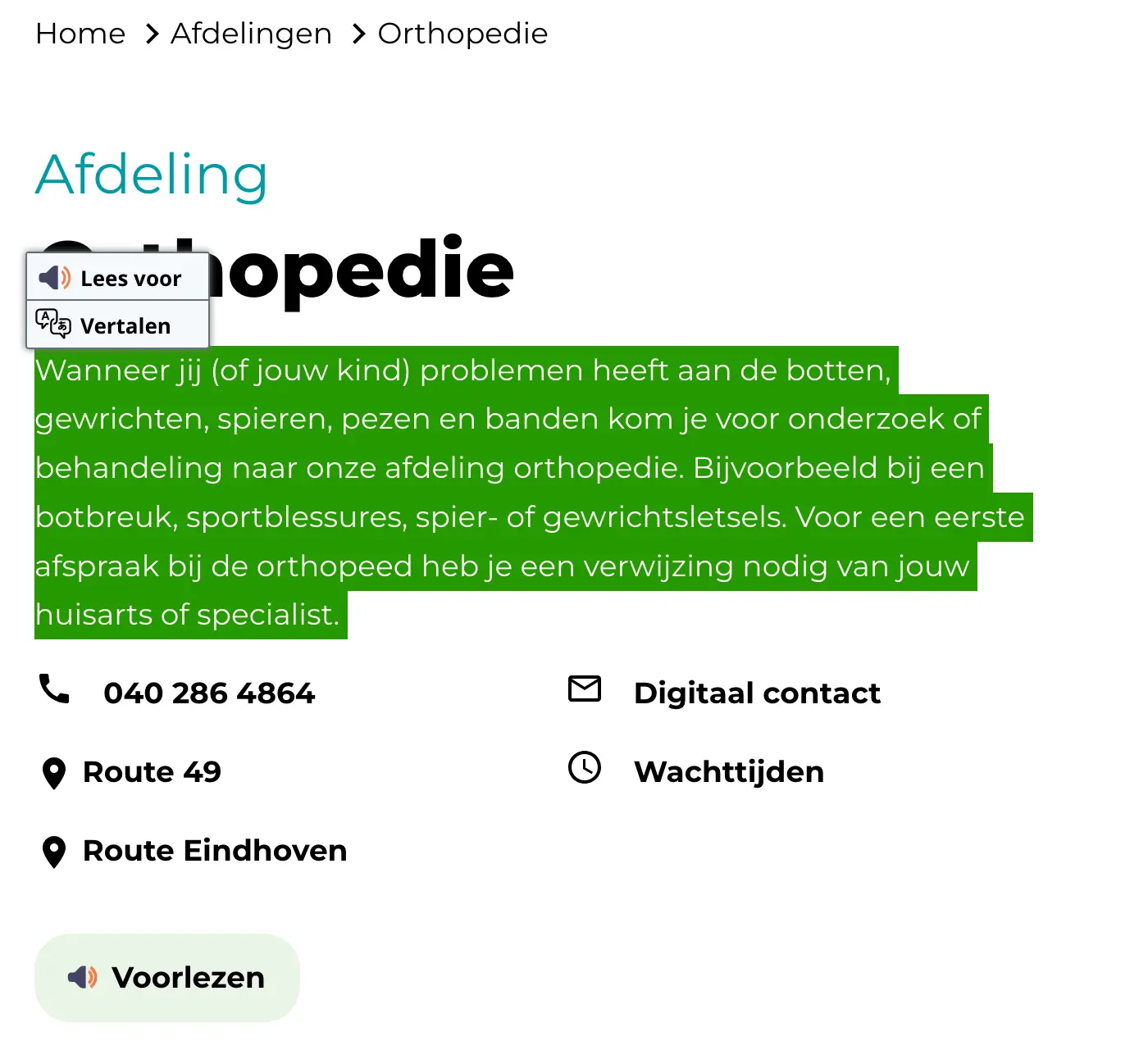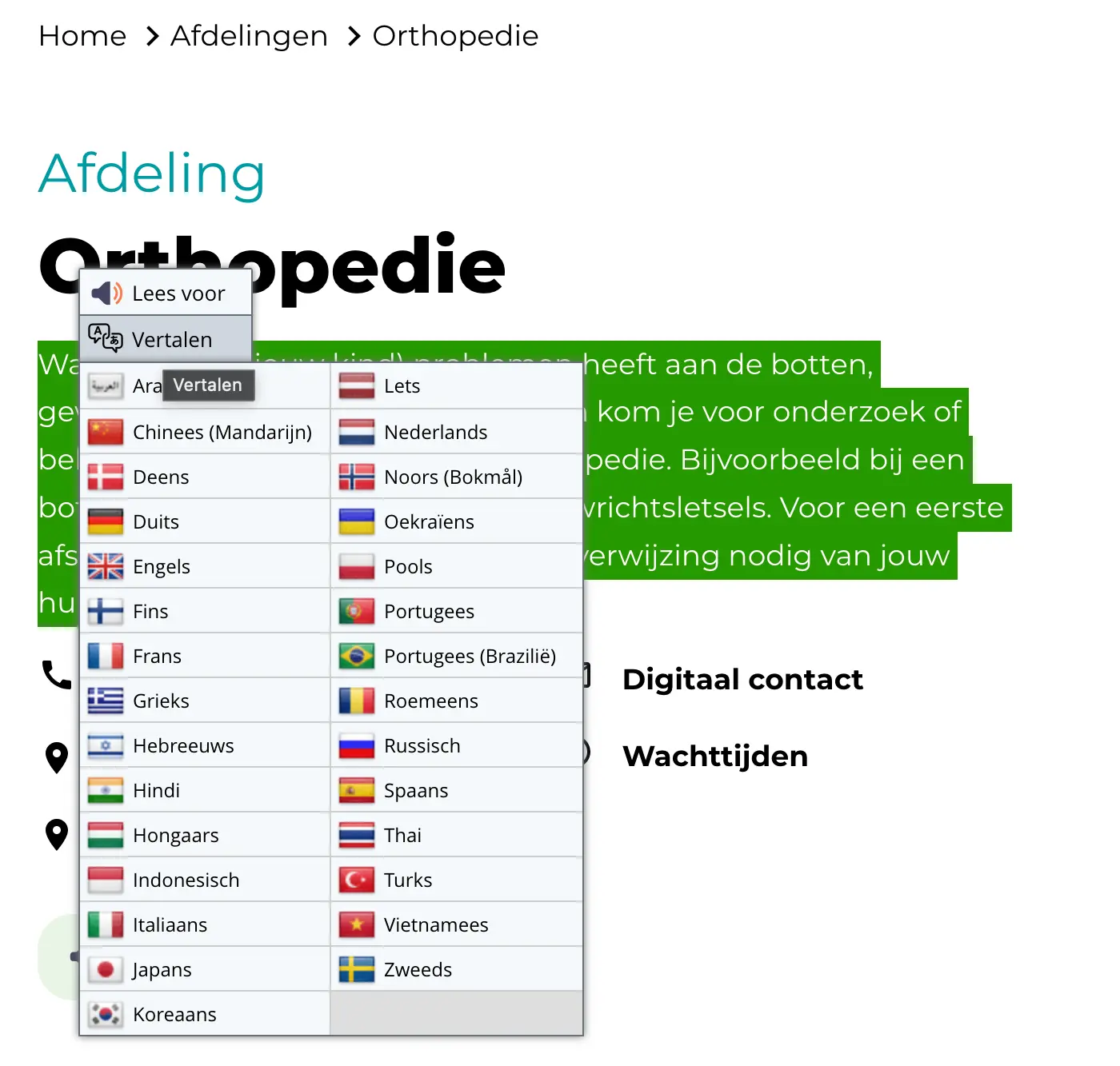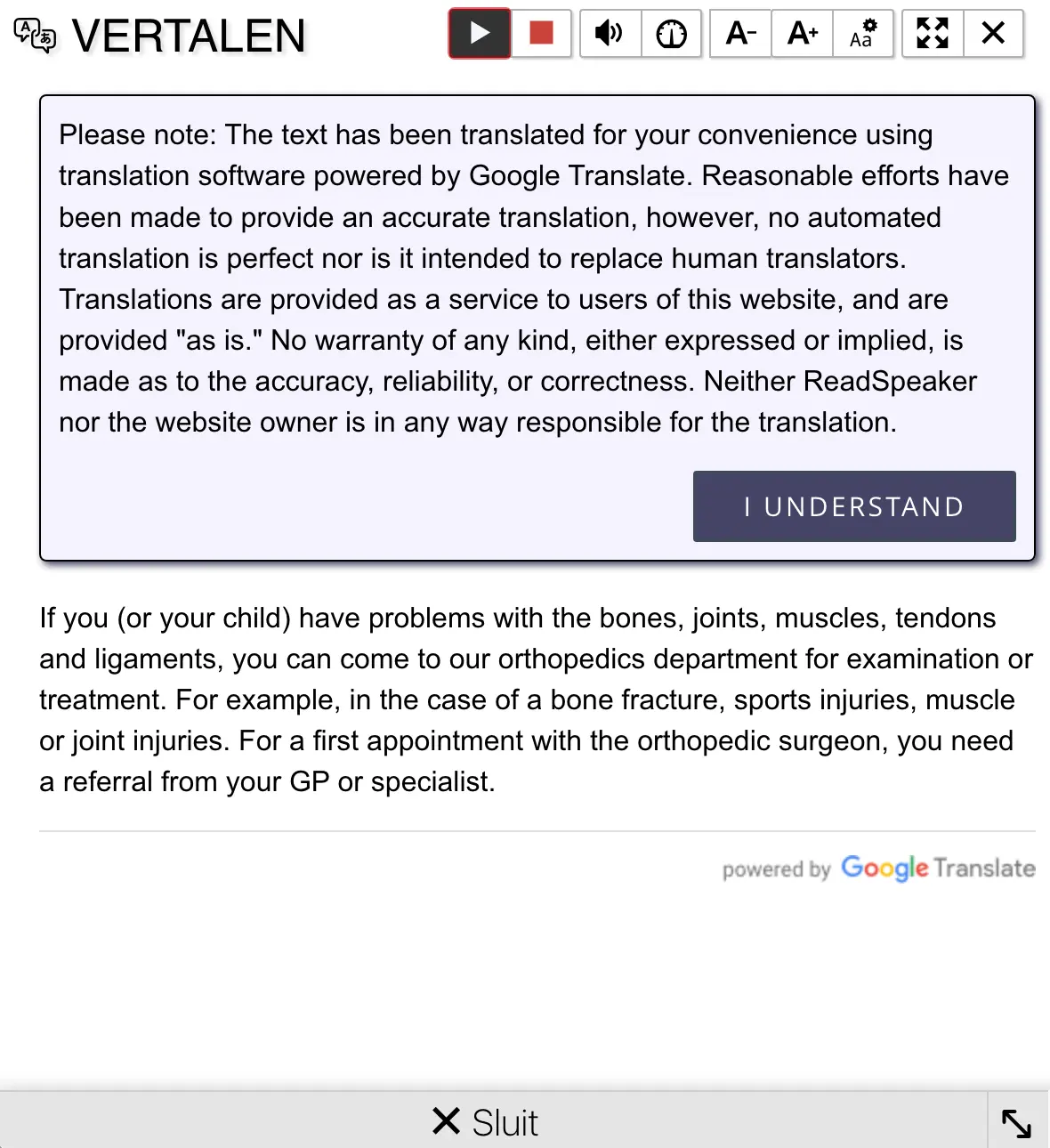Information about anesthesia, pain relief and the operation theater
Anesthesiologie
Introduction
Before you undergo surgery, it is important to know what to expect. The surgeon, the anesthesiologist and their teams will therefore meet with you to give you the information you need verbally. However, it is also important that you can read the information again at your leisure. You already received a booklet about your specific surgery. This complementary booklet contains everything you need to know about the anesthesia, the pain relief and the operating theater.
1. What is anesthesia?
Anesthesiology is the science of anesthesia. Anesthesia is a state of sedation that prevents you from experiencing pain. There are various types of anesthesia:
- General anesthesia
This type of anesthesia puts you to sleep, so you will not experience anything that goes on around you. It is also known as narcosis. - Local or locoregional anesthesia
This type of anesthesia only sedates and relaxes a part of your body.
- Sedation
This can be administered in addition to regional anesthesia. You receive sleep medication via an IV to ensure you are comfortable yet wakeable during the surgical procedure. Some minor procedures can only be performed under sedation. If this is the case for you, it will be discussed during your preoperative anesthesiological screening.
Whether you are eligible for sedation, general anesthesia or locoregional anesthesia depends on the nature of your procedure and your specific health situation. The anesthesiologist ultimately chooses what type of anesthesia you will receive, although they will of course take your preferences into account.
2. Whats important for anesthesia?
Empty stomach
It is very important that you have an empty stomach before the operation.
- Up to 6 hours before admission time, you may eat, drink and smoke.
- Up to 2 hours before admission time, you may only drink water.
It is important to fast before a surgical procedure to ensure your stomach is empty. If that is not the case, the food or fluids in your stomach may end up in your lungs during or around your procedure. This could cause a very severe lung infection and respiratory problems. It is therefore important to follow the fasting guidelines before your surgery. This folder contains a pictogram that clearly illustrates the fasting guidelines (see below).
IMPORTANT: If you do not follow these instructions, your surgery may need to be postponed.
Medication
Any medication marked “continue taking” on the medication overview that will be sent to you or that you were given during your preoperative anesthesiological screening must be taken on the day of your surgery with a small sip of water. For all other medication, we ask that you follow the instructions found on the aforementioned medication overview.
On the day of your procedure, it is important to bring your medication and the medication overview you received with you to the hospital.
Birth control
The medication you receive during your anesthesia may reduce the efficacy of your hormonal birth control. For seven days after your procedure, you should therefore use additional birth control (e.g. a condom) to minimize the risk of pregnancy.
Cosmetics and skin care
Before your hospital admission, please remove any make-up from your face and any (clear) nail polish from your fingers and toes.
If you wear gel or acrylic nails, you must remove these fake nails from at least one finger on each hand - preferably the index finger - to ensure we can reliably and continuously measure your blood oxygen level. We also ask that you do not use any body milk or body lotion on the day of your procedure. Among other things, these products prevent the ECG stickers that are used to monitor your heart rate from properly sticking to your body.
Aids
Glasses, contact lenses, hearing aids and dental prostheses must be removed before you are taken to the surgical ward. It is therefore advisable to bring a protective container of some kind to store them in.
If you use a CPAP device or an anti-snoring mouthpiece (MRA) at home, you must bring these along and use them as instructed during your post-operative stay in the hospital and at home.
Toilet
Make sure to empty your bladder before you are taken to the operating theater.
Allergies
It is important to report all allergies during your preoperative anesthesiological screening and during your hospital admission. In addition to any drug allergies, you must also report any food allergies, etc. This information may be relevant as well.
3. Types of anesthesia
3.1 General anesthesia
General anesthesia involves more than simply putting you to sleep. Depending on the type of procedure you will undergo, a number of goals must be achieved:
- you must not feel any pain during your procedure;
- you must be unconscious during your procedure;
- your vital functions must remain stable.
For some procedures, the following goals also apply:
- your muscles must be relaxed;
- all your unconscious reflexes must be suppressed.
Care during general anesthesia
For each of the aforementioned goals, a separate drug will be administered via an IV. While the drugs are administered, a face mask that supplies oxygen is placed over your mouth, after which you will quickly fall asleep.
The anesthesiologist and the nurse anesthetist will monitor your breathing, heart rate (ECG), blood pressure and the amount of oxygen in your blood (saturation). Based on these values, the anesthesiologist will carefully adjust your anesthesia. If necessary, medical devices are used to temporarily take over certain bodily functions (e.g. your breathing). Any blood or fluids you lose can be replenished. Pain is managed by administering analgesic medication and/or locoregional anesthesia.
During your general anesthesia, a breathing tube is used to support your breathing. What type of breathing tube is used depends on the nature of your procedure. An endotracheal tube is placed in your trachea (past your vocal cords). A laryngeal mask is placed in front of your trachea. This medical device is placed when you are in a deep sleep and taken out once your body is capable of breathing on its own again, just before you fully regain consciousness.
When the administration of the medication is halted, you will wake up from your general anesthesia. After your surgery, a bladder scan will be performed in the recovery ward to check the contents of your bladder. You will also be kept for observation and monitoring. Depending on the contents of your bladder, it may be decided to catheterise you one time to prevent your bladder from becoming too full. For longer surgeries, it may be decided for this reason to place a catheter in your bladder for the duration of your surgery.
Side effects and/or complications of general anesthesia
These days, general anesthesia is very safe. Despite the myriad precautions that are taken, however, complications may still arise. Among the complications you may experience are:
- Nausea and/or vomiting.
- Sore throat and hoarseness (caused by the laryngeal mask or the endotracheal tube).
- Damage to your teeth (a piece of your tooth may break off when placing the laryngeal mask or the endotracheal tube is very difficult).
For more information about general anesthesia and its possible complications, we refer you to the website of the NVA (Dutch Association for Anaesthesiology: www.anesthesiologie.nl/documenten/keuzehulp-anesthesiologie-nva-pfn
3.2 Spinal anesthesia (epidural)
This form of locoregional anesthesia involves numbing the lower half of your body - roughly from your belly button to your toes - by administering a local anesthetic in your back. The injection itself is generally not that painful.
During spinal anesthesia, you will temporarily lose the use of your legs and your reception of pain will be blocked. Note that you may still feel something when your legs are moved and/or touched. You may also experience a tingling or warm sensation in your legs.
Care during spinal anesthesia
You must sit up straight and relax your shoulders as much as possible. The anesthesiologist will determine where the injection should be administered into your back. If you feel a small "shock” during the injection, you can inform the anesthesiologist, but it is important to remain still. The anesthesiologist will administer the anesthetic and then immediately remove the needle from your back. Your body will eventually break down the anesthetic on its own.
The anesthesiologist and the nurse anesthetist will monitor your breathing, heart rate (ECG), blood pressure and the amount of oxygen in your blood (saturation). It is important to say something if you start to experience nausea and/or a feeling of lightheadedness. This may be caused by a loss of blood pressure, which can be corrected by administering medication and IV fluids. This is done via the IV that was placed before the start of your procedure.
If you do not want to be fully awake during your procedure, you can choose to be sedated. This will make it easier for you to relax. Your reflexes, such as your breathing, are not affected. The goal is not to put you into a deep sleep, as with general anesthesia, so you will remain wakeable during the procedure.
After your surgery, a bladder scan will be performed in the recovery ward to check the contents of your bladder.
Depending on the contents of your bladder, it may be decided to catheterise you one time to prevent your bladder from becoming too full. You will also be kept for observation and monitoring. For longer surgeries, it may be decided for this reason to place a catheter in your bladder for the duration of your surgery.
Complications of spinal anesthesia
Spinal anesthesia is very safe. Despite the myriad precautions that are taken, however, complications may still arise. Among the complications you may experience are:
- Nausea and/or vomiting.
- Postdural puncture headache (it is important to inform your nurse or contact the anesthesiology department if you experience this. The telephone number you can call is listed in the back of this booklet).
- Infection.
- Bleeding.
- Paresthesia (shooting pains during the injection).
- Nerve damage.
For more information about spinal anesthesia and its possible complications, we refer you to the website of the NVA (Dutch Association for Anaesthesiology):
www.anesthesiologie.nl --> Documenten --> Keuzehulp Anesthesiologie NVA PFN
3.3 Peripheral nerve block
This is a form of locoregional anesthesia whereby a part of your body (an arm or a leg) is temporarily made numb and unusable. This is done by administering an anesthetic near a nerve, which gradually shuts down the nerve conduction.
Besides the nerve block, it may be decided to use an additional type of anesthesia during your procedure, such as general anesthesia, sedation or spinal anesthesia. This depends on the procedure.
A major advantage of a nerve block is that (depending on the type of medication used) it will eliminate part of the pain for a period of four to twenty-four hours after the surgery, which reduces your need for other forms of pain medication.
Different types of nerve blocks
- Numbing the shoulder/arm/hand (interscalene, supraclavicular or axillary block) The bundle of nerves in the neck/shoulder region or the armpit/upper arm is numbed.
- Numbing of the leg/foot(femoral or popliteal block). The bundle of nerves in the groin or the back of the knee is numbed.
Care during a peripheral nerve block
In the operating theater, you will be connected to various medical equipment: the heart rate monitor (ECG), a blood pressure monitor and a sensor on your finger to measure the amount of oxygen in your blood (saturation). An IV will also be placed to administer medication and IV fluids if necessary.
The anesthesiologist will use an ultrasound device to find the location of the nerves. Next, a needle is used to puncture your skin. Using ultrasound images, the needle is guided to the correct location, possibly with the use of a nerve stimulator that will cause the muscles connected to the nerve to move. Once the needle is in the correct position, the anesthesiologist will administer the anesthetic around the nerve and then remove the needle. A short time later, you will experience a tingling and warm sensation in the limb in question. Later still, you will lose all feeling and most or all mobility in the limb. Your body will break down the medication, which means you will regain feeling in the affected limb after a few hours.
Sometimes, it may be decided to place a small catheter (a thin tube positioned near the bundle of nerves) in your body. This is known as a perineural catheter. This perineural catheter is used to administer analgesic medication after your surgery via a PCPA pump (Patient Controlled Perineural Analgesia). This is done to prolong the analgesic effect of the peripheral nerve block for a longer period of time. In addition to the standard dose, you can also operate the PCPA pump yourself. By pressing a blue button, you can self-administer a dose of analgesia if necessary.
Additionally, a thin catheter may be placed in a wound (e.g. during abdominal surgery). This catheter is also used to administer analgesic medication via an (elastomeric) pump, which will drain on its own within two or three days. If this applies to you, it will be discussed with you prior to your procedure.
After your surgery, a bladder scan will be performed in the recovery ward to check the contents of your bladder. You will also be kept for observation and monitoring. Depending on the contents of your bladder, it may be decided to catheterise you one time to prevent your bladder from becoming too full. For longer surgeries, it may be decided for this reason to place a catheter in your bladder for the duration of your surgery.
Side effects and complications of a peripheral nerve block
The peripheral nerve block is a very safe technique. Despite the myriad precautions that are taken, however, complications may still arise.
Among the complications you may experience are:
- Nerve damage
- Infection
- Bleeding
For more information about the peripheral nerve block and its possible complications, we refer you to the website of the NVA (Dutch Association for Anaesthesiology):
www.anesthesiologie.nl --> Documenten --> Keuzehulp Anesthesiologie NVA PFN
4. Pain relief (analgesia)
During and after your procedure, there are various ways to manage your pain:
4.1 Tablets, capsules or fluids you must ingest.
4.2 Analgesic medication administered via an IV.
4.3 Epidural anesthesia.
It is also possible to combine different types of pain medication (analgesics). This is known as multimodal analgesia. The various analgesics have different effects, which means their efficacy can be increased by combining them.
The available options are briefly explained below. For more information, we refer you to the source listed in the back of this information booklet. Based on your health and the type of procedure you will undergo, the anesthesiologist will decide what method to use. This will be discussed with you during your preoperative anesthesiological screening or in the recovery ward after your procedure.
4.1 Tablets, capsules or fluids you must ingest
These types of pain medication are usually effective for dealing with all forms of light pain. They may be insufficient for dealing with severe pain.
Advantages
- Effective for dealing with most forms of pain.
- No IV needed, you can take them yourself at home.
Disadvantages
- Insufficient for dealing with severe pain.
- Less effective for dealing with respiratory and movement-evoked pain.
- On average, it will take thirty minutes for the effects of the medication to kick in.
- If you feel nauseous or have to vomit, it is best not to use these types of medication.
4.2 Analgesic medication administered via an IV
Analgesic medication administered via an IV is often given in the operating theater. In case of severe postoperative pain, it may be decided to place a pump filled with opiates (morphine-like substances). This is known as a PCIA pump (patient controlled intravenous analgesia). A patient can operate this pump on their own in the recovery ward by pressing the blue button.
Advantages
- Effective for dealing with severe pain.
- Acts fast.
- You can usually administer the pain medication yourself by pressing a button (PCIA pump).
Disadvantages
- You are connected to an IV, which means you cannot go home.
- You may experience unpleasant and severe side effects from the medication, such as nausea and vomiting.
4.3 Epidural anesthesia
The pain is treated by placing an epidural catheter (thin tube) in your back.
This catheter is put in place via an injection in your back before the start of your surgery. When the epidural anesthesia is placed, you will be connected to a heart rate monitor (ECG), a blood pressure monitor and a sensor on your finger to measure the amount of oxygen in your blood (saturation). This technique is used during births, but also (in combination with general anesthesia) during surgery on the lungs and the abdomen. Once the catheter is in place, a PCEA pump (Patient Controlled Epidural Analgesia) can be connected to allow for the continuous or intermittent administration of an analgesic to manage the pain. Additionally, the patient can press the blue button to self-administer a dose of the analgesic if the standard setting proves insufficient.
Advantages
- Effective for dealing with severe pain; even respiratory and movement-evoked pain.
- Affects the operation area.
- Does not affect your consciousness.
- Acts fast.
- Can be administered for days after the surgery.
- Can be self-administered via a PCEA pump (Patient controlled Epidural Analgesia).
Disadvantages
- Risks of the injection/placement (e.g. possible nerve damage, infection, bleeding and postdural puncture headache).
- The placement can sometimes be difficult.
- You will receive an IV and often a urinary catheter.
- Side effects such as low blood pressure and loss of strength in the legs.
- Dislocation of the catheter.
5. Operating theater
5.1 Routing
When you arrive in the operating theater prior to your surgery, you will take a certain route (illustrated below):

From the nursing ward, you are taken to the transfer room and handed over to the staff of the operating theater. They will take you to the holding area (preparation room). There, you will be connected to a heart rate monitor (ECG), a blood pressure monitor and a sensor on your finger to measure the amount of oxygen in your blood (saturation). An IV will also be put in place. If you are to receive a peripheral nerve block, you will be taken to the recovery ward instead of the holding area, so the peripheral nerve block can be placed there and it is given enough time to take effect.
Next, you will be taken to the operating room where the general anesthesia or spinal anesthesia is administered. Once one of these techniques has been carefully tested, your surgery can begin. You will regain consciousness in the operating room.
After your surgery, you will be brought to the recovery ward for further observation and monitoring. Once you are stable enough, you can return to your own ward. You will be brought back to the transfer room and handed over to your ward nurses.
5.2 Staff in the operating theater
The anesthesiologist is responsible for your care before, during and after your procedure. Before the procedure, a member of the preoperative anesthesiological screening staff and the anesthesiologist will carefully assess your physical condition. This is important in order to minimize the risks associated with the chosen method of anesthesia.
During the procedure, the anesthesiologist will apply the selected anesthesia technique and make any necessary adjustments. After the procedure, the anesthesiologist will make sure you wake up comfortably. They will then discuss the appropriate pain medication with you.
During your procedure, the nurse anesthetist is in charge of constantly monitoring your anesthesia, breathing, heart rate and blood pressure. This constant care is provided under the supervision of the anesthesiologist.
The nurse anesthetist assists the anesthesiologist during the start and end of the anesthesia and they stay at your side during the procedure. In addition to caring for you in the operating room, the nurse anesthetist may also form part of the preoperative anesthesiological screening staff.
The surgical specialist performs the surgery in the operating room. The are assisted by scrub nurses. Two or three scrub nurses are present during a surgical procedure. Together with the surgical specialist, they make sure the surgery proceeds smoothly. The scrub nurses each have their own core task: instrumentation, assisting or peripheral tasks.
Recovery nurses are specialized nurses. Prior to and especially after a procedure, they monitor your blood pressure, heart rate and the amount of oxygen in your blood in the recovery ward. They also examine your wound and perform the “pain score” test. Based in part on the results of this test, the anesthesiologist will choose a suitable form of pain medication for you. The staff of the operating theater will make sure you are never left alone until you are retrieved by your ward nurses after your procedure. In addition to caring for you in the recovery ward, the recovery nurse may also form part of the preoperative anesthesiological screening staff.
5.3 Sectio caesarea (cesarean section) in the operating theater
The pregnant patient and her partner are taken to the children's recovery room (separate area) in the operating theater by their ward nurse. When the patient is taken to the operating room, her partner and the ward nurse will wait until the preparations for the surgery are complete (e.g. connecting the monitoring equipment, administering the spinal anesthesia and positioning the patient).
When the preparations are done, the partner and the ward nurse may also enter the operating room. After the cesarean section, the mother, her partner and their baby go back to the children's recovery room (provided that mother and child are sufficiently stable).
6. Safety and quality standards
The Anna Hospital wants to provide the care you need in an optimally safe environment. We have therefore partnered with Qualicor (formerly known as NIAZ). Qualicor is an independent institute that defines quality standards for health care institutions and conducts audits at their request. Visit www.qualicor.eu for more information.
To ensure we can provide the safest and best possible care, we will assume that you have reported any and all special circumstances related to your health situation as comprehensively as possible. If there is anything you would like to add or if there are any changes to your health situation or use of medication, please inform the anesthesiology team. If you experience any severe side effects and/or complications after your procedure that may be related to the anesthesia, please call the number listed below.
7. Questions
Our goal is to inform you as well as possible about what to expect. You have therefore met with your surgeon, anesthesiologist or a member of the anesthesiological screening staff. Additionally, it is helpful to be able to read more about your specific surgery, the anesthesia method used and how things are done in the operating theater. We hope that this information booklet has answered any questions you may have had and that it has put your mind at ease about your upcoming surgery.
Contact
If you have any further questions about your procedure, you can contact us by calling the number below:
Preoperative anesthesiological screening: 040 - 286 48 10
For more detailed information about the various types of anesthesia, we refer you to the website of the NVA (Dutch Association for Anaesthesiology): www.anesthesiologie.nl --> Documenten --> Keuzehulp Anesthesiologie NVA PFN
Pictogram "Fasting"




